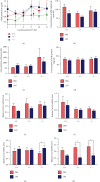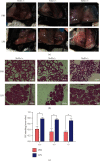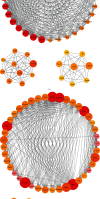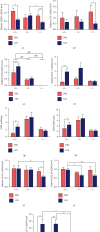Nrf2-ARE Signaling Partially Attenuates Lipopolysaccharide-Induced Mammary Lesions via Regulation of Oxidative and Organelle Stresses but Not Inflammatory Response in Mice
- PMID: 33505589
- PMCID: PMC7810562
- DOI: 10.1155/2021/8821833
Nrf2-ARE Signaling Partially Attenuates Lipopolysaccharide-Induced Mammary Lesions via Regulation of Oxidative and Organelle Stresses but Not Inflammatory Response in Mice
Abstract
The incidence of mastitis is high during the postpartum stage, which causes severe pain and hinders breast feeding in humans and reduces milk production in dairy cows. Studies suggested that inflammation in multiple organs is associated with oxidative stress and nuclear factor E2-related factor 2 (Nrf2)-antioxidant response element pathway is one of the most important antioxidant pathways, but the effects of Nrf2 on antioxidation in the mammary gland during mastitis are still unclear. In this study, intramammary lipopolysaccharide (LPS) challenge was carried out in wild-type (WT) and Nrf2 knockout mice. Results showed that the expression of Nrf2 affected the expression of milk protein genes (Csn2 and Csn3). Importantly, LPS treatment increased the expression of Nrf2 and HO-1 and the content of glutathione in the mammary gland of WT mice, but not in Nrf2(-/-) mice. The expression levels of glutathione synthesis genes (GCLC, GCLM, and xCT) were lower in Nrf2(-/-) mice than in WT mice. Moreover, mitochondrial-dependent apoptotic and endoplasmic reticulum stress were significantly relieved in WT mice compared with that in Nrf2(-/-) mice. In summary, the expression of Nrf2 may play an important role in prevention of oxidative and organelle stresses during endotoxin-induced mastitis in mouse mammary gland.
Copyright © 2021 Yongxin Li et al.
Conflict of interest statement
All the authors declare that they have no conflict of interests.
Figures






Similar articles
-
Suppression of Fpr2 expression protects against endotoxin-induced acute lung injury by interacting with Nrf2-regulated TAK1 activation.Biomed Pharmacother. 2020 May;125:109943. doi: 10.1016/j.biopha.2020.109943. Epub 2020 Feb 25. Biomed Pharmacother. 2020. PMID: 32106380
-
Vitexin attenuates lipopolysaccharide-induced acute lung injury by controlling the Nrf2 pathway.PLoS One. 2018 Apr 25;13(4):e0196405. doi: 10.1371/journal.pone.0196405. eCollection 2018. PLoS One. 2018. PMID: 29694408 Free PMC article.
-
Sigma 1 receptor regulates the oxidative stress response in primary retinal Müller glial cells via NRF2 signaling and system xc(-), the Na(+)-independent glutamate-cystine exchanger.Free Radic Biol Med. 2015 Sep;86:25-36. doi: 10.1016/j.freeradbiomed.2015.04.009. Epub 2015 Apr 25. Free Radic Biol Med. 2015. PMID: 25920363 Free PMC article.
-
Bardoxolone treatment alleviates lipopolysaccharide (LPS)-induced acute lung injury through suppressing inflammation and oxidative stress regulated by Nrf2 signaling.Biochem Biophys Res Commun. 2019 Aug 13;516(1):270-277. doi: 10.1016/j.bbrc.2019.06.006. Epub 2019 Jun 24. Biochem Biophys Res Commun. 2019. PMID: 31248593
-
GPR109A alleviate mastitis and enhances the blood milk barrier by activating AMPK/Nrf2 and autophagy.Int J Biol Sci. 2021 Oct 17;17(15):4271-4284. doi: 10.7150/ijbs.62380. eCollection 2021. Int J Biol Sci. 2021. PMID: 34803497 Free PMC article.
Cited by
-
Continuous Theta Burst Stimulation Inhibits Oxidative Stress-Induced Inflammation and Autophagy in Hippocampal Neurons by Activating Glutathione Synthesis Pathway, Improving Cognitive Impairment in Sleep-Deprived Mice.Neuromolecular Med. 2024 Oct 10;26(1):40. doi: 10.1007/s12017-024-08807-z. Neuromolecular Med. 2024. PMID: 39388015
-
The Role of Organosulfur Compounds as Nrf2 Activators and Their Antioxidant Effects.Antioxidants (Basel). 2022 Jun 26;11(7):1255. doi: 10.3390/antiox11071255. Antioxidants (Basel). 2022. PMID: 35883746 Free PMC article. Review.
References
MeSH terms
Substances
LinkOut - more resources
Full Text Sources
Other Literature Sources
Molecular Biology Databases
Research Materials
Miscellaneous

